What you should know before buying a toy: compare theme, age and price
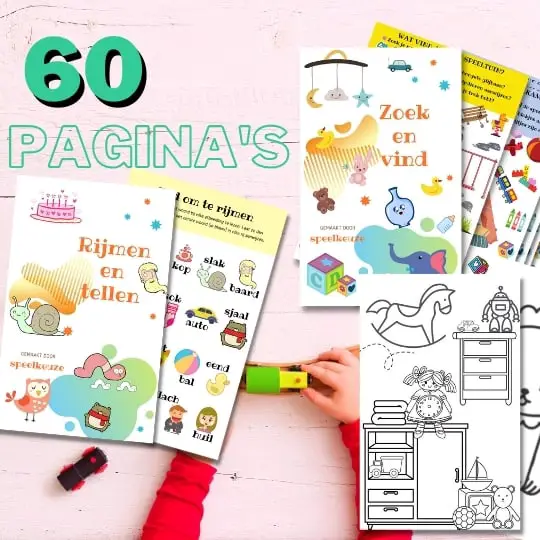
Always something to do for the holidays or rainy day?
Play Choice now has the ultimate activity book collection, with over 60 pages of fun coloring pages and educational puzzles.
Toys are objects designed for children to play with and have fun. The main synonym is 'plaything', but there are more synonyms.
I'll cover a variety of topics including the materials toys are made of, the themes toys are available in, the important role of age range in choosing toys, and the importance of color choice.
Comparing toys within price ranges will also be discussed.
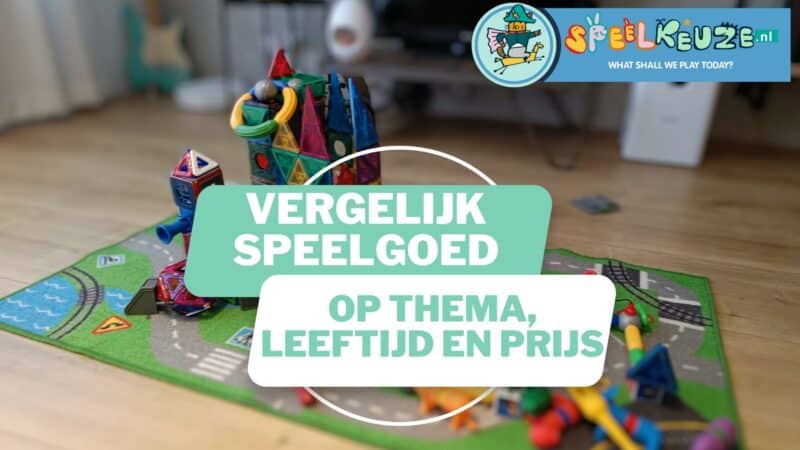
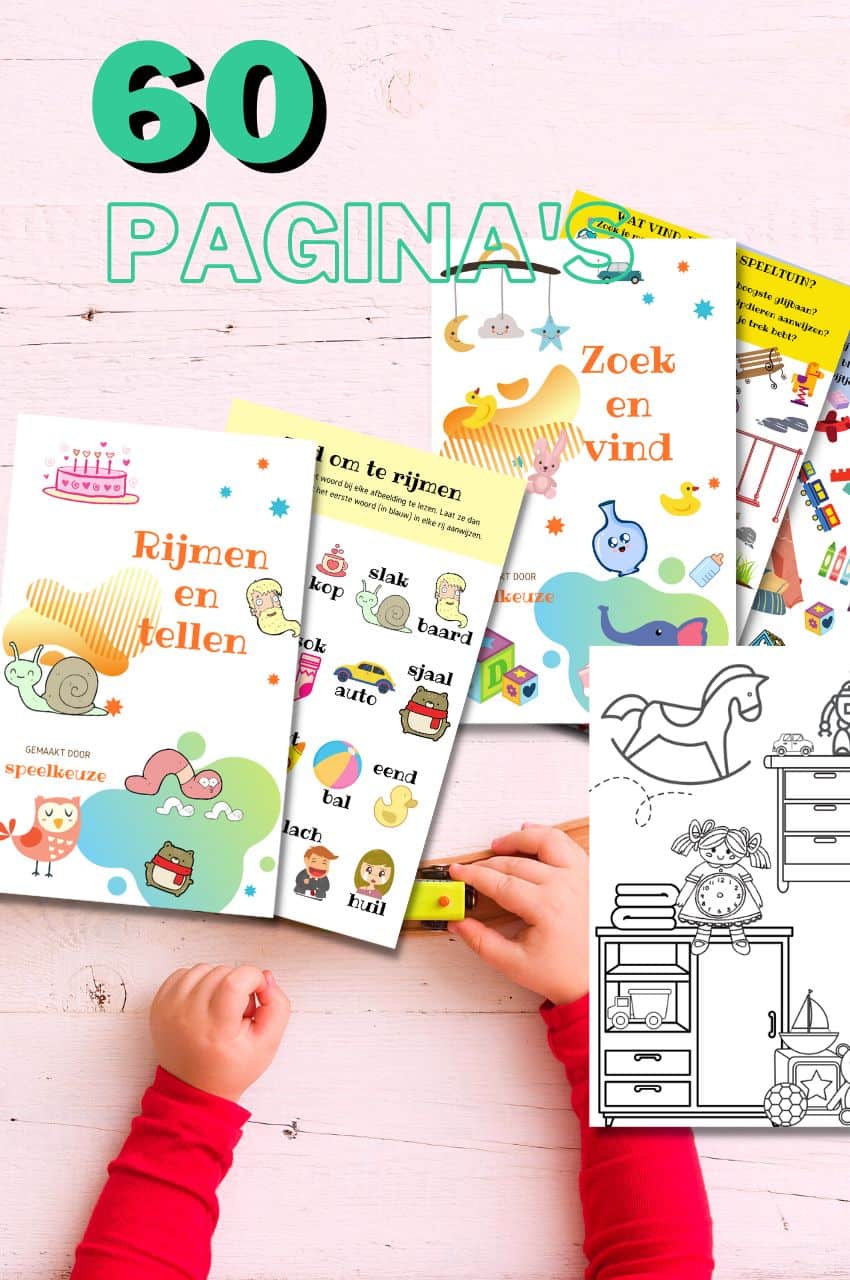
From toddler to toddler activity book collection
Educational games and coloring pages for 3 to 6 years
Your toddler and preschooler will love this e-book, along with the accompanying printables. He or she can play with it at every stage of development, together with mom and dad.
Buy at Bol.comWhat we discuss in this comprehensive post:
- 1 What is the definition of toys?
- 2 Who are the toys for?
- 3 What makes toys suitable for adults?
- 4 What themes are there for toys?
- 5 What materials are toys made of?
- 6 Why is the size of toys important?
- 7 What toy color options can you consider?
- 8 Why should you compare toys in similar price ranges?
- 9 Why are age categories important for toys?
- 10 What else can you look for when buying toys?
- 10.1 Which toy brands are recognizable?
- 10.2 How do you find toys that are suitable for special needs?
- 10.3 Should I look at the learning purpose of toys when choosing?
- 10.4 What makes toys quality?
- 10.5 What additional features should I consider?
- 10.6 Do I have to take the playing environment of the toy into account?
- 10.7 What Makes Toys High or Low Maintenance?
- 11 What toy alternatives are there?
What is the definition of toys?
Toys are objects designed to be played by children for amusement and entertainment.
The official definition of the Toys Directive 2009/48/EC is any product specifically designed or clearly intended for use by children under the age of fourteen during play. The primary purpose of the product is focused on play activities.
The main synonym is 'toy'. However, other synonyms have arisen throughout history. Toys are made of different materials such as plush, plastic, wood and electronic components. Examples of toy themes include dolls, model cars, stuffed animals, building blocks and puzzles.
What is the main synonym for toys?
The main synonym for toys is "playthings". According to the Thesaurus, this is the most relevant word for a toy because it captures the essence of a toy: something to play with. Other synonyms for toys are "game", "pastime", "knick-knacks", "curiosities", "gadget" and "gewgaw".
The word "game" can be used when the toy is a specific game, such as a board game or a card game. “Pastime” can be used if the toy is intended to kill time, such as a puzzle or a book of games. “Knick-knacks” and “curiosities” are more applicable to decorative objects that double as toys, such as a collection of miniature cars. “Gadget” and “gewgaw” are often used for technological toys, such as a drone or a robot.
What is the history of toys?
Toys have always been a part of the human experience, from simple objects such as sticks to clay and wooden figures. The oldest known toy dates back to 4000 BC, discovered in Kültepe, Turkey.
These early toys were probably made by parents and consisted of natural materials such as clay, wood and stone. They include simple models of animals and people.
Toys have developed throughout history, reflecting technological progress and societal changes. Plastic toys became popular in the 20th century and continue to dominate the market today, with colorful options that encourage children's creativity.
Although toys have evolved, the purpose remains the same: to have fun and learn through play.
Who are the toys for?
Toys intended for children are different from toys for adults. It is important to consider the target audience when choosing toys.
For children, the toys should be age-appropriate and safe. Boys and girls may have different preferences, with boys often leaning towards action figures and cars, while girls may prefer dolls and craft supplies. Boys and girls are therefore very different target groups for toys.
Adults may appreciate more complex toys, such as puzzles or board games. The elderly are yet another target audience for toys and may appreciate nostalgic toys that remind them of their childhood.
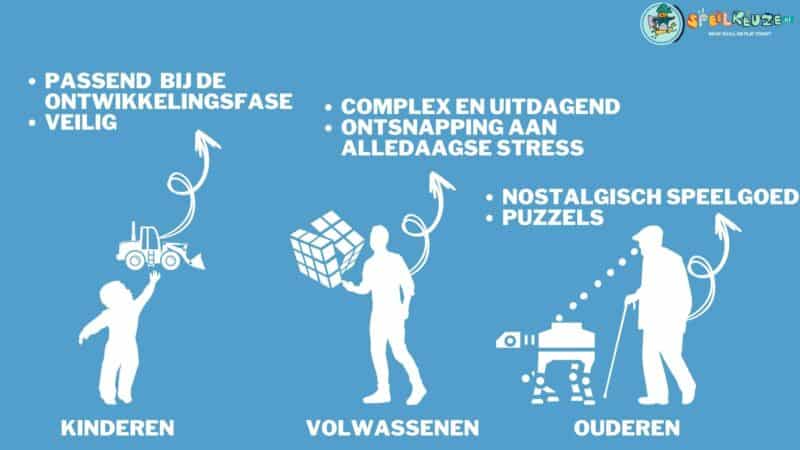
And let's not forget pets, who have their own toys designed specifically for their needs. Ultimately, understanding who the toy is intended for is crucial to ensuring it's enjoyable and used properly.
What makes toys great for kids?
A children's toy must be suitable for the age and developmental stage of the child. This is shown by a study by Bantz and Siktberg (1993) who argues that parents do not have to buy the most expensive or most advertised toys to promote their child's growth and development.
It's important for parents to understand how to evaluate and use toys to stimulate their child's development without frustrating or overstimulating the child. This applies to all parents, regardless of their income, education and resources.
There are differences between boys and girls when it comes to toys. Girls are often interested in dolls and craft supplies, while boys are more interested in cars and building sets. However, it's important to emphasize that toys should be seen as gender-neutral and that boys and girls should be able to play with all types of toys.
What makes toys suitable for adults?
Toys for adults should be engaging, entertaining and provide a break from the stress of everyday life. Unlike children's toys, toys for adults are usually designed to be more challenging and complex. They can also be electronic, such as video games and remote-controlled cars, or physical, such as desk toys and puzzles.
Toys can also be beneficial for the elderly, as shown in a study by Cota, Ishitani, and Vieira (2015) on the design of mobile games for the elderly. The study showed that digital games can help prevent and treat cognitive impairment caused by aging. The study also identified key features that motivate older people to play mobile games, including the genre of the game and its ability to help with cognitive impairment.
Popular toys for adults include construction toys, open-ended toys, creative toys, movement toys, musical and noise toys, small world toys, and wooden toys. These toys can provide a sense of nostalgia and the opportunity to be a kid again for a while.
What do pets need in toys?
A pet toy should be fun and engaging for the pet. It must be suitable for their size and strength, and made of safe materials. The toys should also be challenging to stimulate their curiosity and intelligence.
A toy that is interactive and engages the owner in play can also help strengthen the bond between pet and owner.
What themes are there for toys?
Toys come in different themes. Below is a list of the most common themes:
- Vehicles: toy cars, trains, planes and boats.
- Animals: cuddly toys, toy horses, dinosaurs and other wild animals.
- Props: toy tools, kitchen supplies, and doctor supplies.
- Occupations: toy fire trucks, police cars and doctor sets.
- Care play: dolls, babies and care sets.
- Monsters: dragons, zombies and other fantasy creatures.
- Games: board games, card games and puzzles.
- Arts/Crafts: clay, paint and craft kits.
- Food: toy food, kitchen sets and tea sets.
- Fidget toys: stress balls, cubes and spinners.
- Building toys: blocks, lego and other building sets.
This toy themes offer children a wide range of play options and stimulate their creativity and imagination.
What materials are toys made of?
Not all toy materials are created equal, so here's a list of popular toy materials and their pros and cons.
- Plush: Soft and cuddly, but can be difficult to clean and contain allergens.
- Cast Iron: Durable and detailed, but can be heavy and contain harmful chemicals.
- Plastic: Lightweight and versatile, but can break easily and may not be environmentally friendly.
- Cardboard: Affordable and recyclable, but not very durable and may not withstand rough play.
- Metal: Strong and long lasting, but can be heavy and have sharp edges.
- Wood: Natural and sturdy, but may splinter and not suitable for young children.
- Fabric: Soft and flexible, but may require special care and be a fire hazard.
- Foam: Lightweight and safe, but may be less durable and easily torn or damaged.
The toy material choice also affects the texture.
Why is texture important for toys?
Texture is also important for toys, especially for babies and toddlers.
According to a systematic review by Dusing (2016), young infants use sensory information to modify motor behavior and learn from their experiences. This means that babies develop skills through a link between their sensory and motor systems. The texture of toys plays a vital role in this process as it provides different sensory experiences that help babies and toddlers learn about their environment.
In addition, the texture of toys can also provide other benefits, such as improving fine motor skills, hand-eye coordination and cognitive development. For example, toys with different textures can help babies and toddlers develop their sense of touch and improve their ability to differentiate between different textures. This can also help them learn about cause and effect as they explore the different textures of toys.
Why is the size of toys important?
The size of toys is important when choosing age-appropriate toys because it's directly related to the toy's safety and playability.
Safety is a major concern, especially for younger children with smaller airways that can easily become blocked. Smaller toys may pose greater risks as they may fit completely in a child's mouth and present a choking hazard.
To determine if a toy is too small, a small parts tester or choking tube can be used. This will help you determine if the toy is small enough to fit into the three tubes designed to match the diameter of a child's trachea. If an object fits in the tube, it is too small for a young child.
The size of toys is also important for storage. Smaller toys are easier to carry and can be taken to different rooms in the house or outside. This makes it easier for a child to play with the toy in different locations.
Do you have enough space to store the toys?
You should have enough space to store the toys. For small toys, you can use a drawer or a basket. For medium-sized toys, you can use a shelf or a box. For large toys, you can use a storage box or a cabinet.
Be sure to neatly store and label the toys so you can find them easily when you need them.
What toy color options can you consider?
The most common colors for toys vary depending on several factors, such as trends, cultural preferences, and the target audience of the toy.
The colors used in toys can have an effect on children's mood and perception. For example, red represents energy, excitement and stimulation and blue is associated with calmness, tranquility and confidence.
Typical boy and girl colors do not matter, according to a study by Jadva, Hines and Golombok (2010). Only the shape (or theme) of toys has intrinsically different interests for men and women.
Bright colors are especially important for toys because they are visually appealing to children and help develop visual perception. Children are naturally drawn to bright colors and babies, in particular, can perceive them better than dull shades.
Colorful toys help babies develop vision and visual perception, while learning colors helps children estimate, judge and define objects.
Why should you compare toys in similar price ranges?
You should compare toys within price ranges because it helps you get your money's worth. By comparing toys that are similarly priced, you can better judge which toys offer the best quality for your budget.
Whether you're looking for budget-friendly toys or are willing to spend more on premium or expensive toy items, comparing within price ranges is key to finding the best toy for your money.
It's easier to compare toys on factors such as durability, safety, educational value and fun.
Why are age categories important for toys?
Age categories are important for toys as they ensure the safety and developmental appropriateness of the toy for the age of the child. Babies, toddlers, schoolchildren and teenagers are at different levels of physical, cognitive, social and emotional development, and toys suitable for each age differ accordingly.
The age categories are based on the safety requirements set for toys by the European Toy Directive 2009/48/EC.
For safety reasons, age ranges ensure that the toys are safe for children to use. Toys that are too sophisticated for a child's age can be dangerous and lead to injuries. Age ranges are determined based on safety factors and children's physical capabilities. For example, toys with small parts can be a choking hazard for younger children.
In addition to safety, age ranges for toys make it toys are developmentally appropriate for the age of the child. Toys that are too simple or too complex for a child's age can be boring or frustrating.
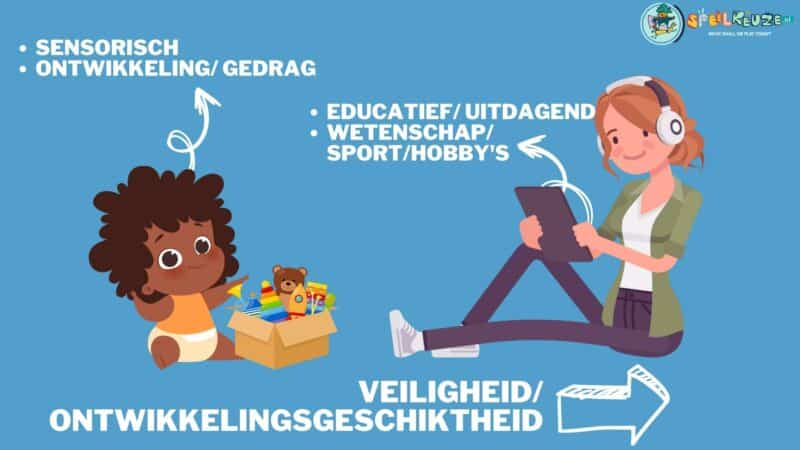
What are suitable toys for babies?
Toys for babies should be appropriate for their age and stage of development.
Suitable toys for babies of 0-3 months include soft balls, rattles, large rings, squeeze toys, teething toys, soft dolls, textured balls, vinyl board books, mobiles with contrasting patterns and colors.
For babies of 3-6 months, activity gyms, soft blocks, stacking cups, teething rings, board books with simple pictures and textures, soft toys with different textures and sounds, and musical toys are suitable.
Babies of 6-9 months enjoy push and pull toys, stacking cups and boxes, shape sorting toys, bath toys, balls, simple story board books, and toys with buttons, levers, and dials.
For babies of 9-12 months, walkers, blocks, simple puzzles, musical instruments, dolls, stuffed animals, toy telephones, kitchen sets and balls of different sizes and textures are suitable.
What are suitable toys for toddlers?
Toys for toddlers are often designed with 3 factors in mind: development and behavior, play methods and safety. According to a study by Thangthong, Louhapensang and Suttiwan (2019), these factors are essential when designing toys suitable for children aged 0-3.
The study found that toys designed with these factors in mind showed good levels of playtime and were rated positively by parents. Compared to samples from the Toy Industry Association of Thailand, the survey showed a moderate level of satisfaction in all aspects.
What are suitable toys for school children?
Toys for school children should be age appropriate, safe and educational. Board games, card games, and sports equipment such as balls, jump ropes, and hula hoops are good options for elementary school children ages 6 to 11.
Science sets, art and craft materials such as beads, yarn and fabric can also promote creativity and learning. Building sets such as Legos and musical instruments are also good choices. Educational toys that promote STEM learning are highly recommended, as are books that can help improve reading and comprehension skills.
What are suitable toys for teenagers?
Toys for teens should be age appropriate and not too childish. Suitable options include board games, puzzles, video games, sports equipment, and creative sets such as art supplies or DIY projects.
It's important to consider the interests and hobbies of the individual teen when selecting toys. Avoid toys that are too childish as they may be considered offensive to their maturity.
When are toys suitable for all ages?
Toys suitable for all ages have one thing in common: they're designed to work for all stages of academic and cognitive development. Such toys are suitable for everyone from toddlers to adults.
They're versatile and can be used in a variety of ways depending on the age and skill level of the user.
For example, building blocks can be used to teach young children about shapes and colors, while older children can use them to create more complex structures. Similarly, puzzles can be used to teach problem-solving skills to young children, while adults can use them to challenge their cognitive skills.
In general, toys that are suitable for all ages are toys that can be adapted to different developmental levels and provide a range of learning experiences.
Why should you look at academic development when buying toys?
Academic development indicators are important to consider when buying a toy. Not all children are at the same level of development, regardless of their age.
For example, a 5th grade student may have different academic needs than a preschooler or a 3rd grade student. By focusing on academic development rather than just age range, you can ensure that the toys you choose are both engaging and beneficial to the child.
Why should you look at cognitive development when buying toys?
You should also look at cognitive development when buying toys. It's important to select toys that match the developmental stage of the child.
For the preoperational stage, toys that stimulate the imagination, such as dolls and toy kitchens, are suitable. Puzzles and building sets are good options for the concrete operational phase. For the sensorimotor phase, toys that stimulate the senses, such as rattles and toys with bright colors, are suitable. For the formal operational phase, games that require logical thinking, such as chess and puzzles, are suitable. For the development of young children, toys that promote fine motor skills, such as blocks and shape sorters, are suitable.
What else can you look for when buying toys?
Other things to consider when buying a toy include the brand, special needs toys, the focus on learning, the quality of the toy, additional features and the environment in which the toy will be used (such as indoor/outdoor and in the bath).
Which toy brands are recognizable?
Brands can help you decide which toys to buy. Some of the most recognizable toy brands are Lego, Barbie, Fisher-Price, Hot Wheels, Hasbro, Mattel, Nerf, Brio Trains, Melissa & Doug, Funko Pop, Magic: The Gathering, MGA Entertainment, Land Dough, Uncle Goose, Little Builders, Green Toys, Sand Toys , Tender Leaf Toys, Elenco Electronics Inc and Fat Brain Toy Co.
Big brands also often collaborate with movies, books and cartoons to develop toys that are popular with children. Top brands also feature regularly in review videos, making it easier for parents to choose quality toys for their children.
Why are toys from movies, books or cartoons instant hits?
Adaptations of children's toys based on films, books and cartoons are instant hits because children recognize them immediately.
Toys inspired by popular movies, books and cartoons grab children's attention because they're already familiar with the characters and stories. It's a way for kids to experience their favorite characters and stimulate their imagination.
How can watching toy review videos help you choose?
Toy review videos can be a great resource to help you choose the right toy.
Watching these videos will give you a better idea of the features and quality of different toy products. This can help you distinguish between high-quality brands and brands that may be less good.
In addition, toy review videos can give you an idea of how the toy actually works and how it can be used in real life. This can be especially helpful if you're hesitating between multiple toy options that seem similar at first glance.
How do you find toys that are suitable for special needs?
Finding toys that are suitable for special needs can be a challenge. However, special toy options are available for children with autism and children with visual impairments.
A study conducted by DiCarlo, Schepis, and Flynn (2009) showed that embedding preferred sensory traits in toys increased the play behavior of toddlers with disabilities. This was achieved by using preference rating technology to identify the child's favorite sensory trait and embed it in a non-preferred toy. The results showed that this increased independent functional play time for all three children in the study.
In addition to toys for children with disabilities, toy options are also available for people with dementia. These toys are designed to provide sensory stimulation and can help reduce agitation and anxiety. Examples of such toys include fidget blankets, sensory balls, and puzzles with large, easy-to-grip pieces. By providing appropriate toys, caregivers can improve the quality of life for people with special needs.
Should I look at the learning purpose of toys when choosing?
Yes, you should definitely look at the learning objective when selecting toys. It is important to choose toys that suit the child's developmental needs, such as STEM/STEAM fine motor toys, logic toys, speech therapy toys, hand-eye coordination toys, sensory toys, motor skills toys, and children's toys. imaginative game.
The learning purpose is one of the most important characteristics of a toy to base your purchase on.
What makes toys out of quality?
A quality toy is composed of several important elements, including the following.
- Age appropriateness: The toys should be appropriate for the child's age and stage of development.
- Playability: The toy should be easy to use and challenge the child to play and explore.
- Durability: The toy must be sturdy and resistant to intensive use and wear.
- Safety: The toy must meet safety standards and not pose a risk to the child.
- Educational value: The toy should contribute to the development of the child, such as stimulating motor, cognitive and social skills.
- Interactivity: The toy should be interactive and challenge the child to interact and play together.
- Versatility: The toy should be able to be used in different ways and challenge the child to experiment and discover.
- Timeless appeal: The toy should be timeless and continue to captivate the child even as they grow older.
- Aesthetics: The toy should look attractive and appeal to the child.
- Value for money: The toy should be good value for money and worth the investment.
The choosing quality toys ultimately saves money because of the play value you get from it.
What additional features should I consider?
The 3 most important additional features of toys to consider are as follows.
- Mode of Play: It's important to consider whether the toy can be played solo, co-operatively, or competitively. This can promote teamwork, group play, or collaboration.
- Safety features: It is important to check that the toy has rounded edges, is made of non-toxic materials and has safety certifications. It should not contain small parts.
- Playtime: It's important to consider whether the toy can be played quickly, provides long-term engagement, or allows for extended play sessions.
In addition to these features, there are also important technical specifications to consider and the packaging also matters.
Why do you also need toys for independent play?
Independent play, sometimes referred to as independent play, means that children play alone without direct adult guidance. Toys for independent play is essential as it allows children to develop their creativity, build self-confidence and solve problems without direct guidance. It also gives you some free time while your kids entertain themselves.
Which technical specifications of toys matter most?
The 3 most important technical specifications to consider when buying a toy are: battery-powered (requires batteries or battery-free), sound level (silent or with sound effects/music) and interactivity level (with speech recognition, motion detection or touch sensitivity).
Does packaging matter when comparing toys?
Yes, packaging is important when comparing toys. Good packaging can make the toy look more attractive and can also help protect the toy from damage during transportation.
In addition, it's important to look at the ecological footprint of the packaging. Eco-friendly and recyclable packaging is better for the environment and can help reduce waste.
It's therefore important to look not only at the toy itself, but also at the packaging.
Do I have to take the playing environment of the toy into account?
You have to take the playing environment of the toy into account. For example, with toys for the sandbox, you should pay attention to the size and material of the toy, while toys for the car should be safe and compact.
For outdoor toys, you should pay attention to durability and weather resistance, while toys for the water should be waterproof and buoyant. For toys in the high chair, you should pay attention to the size and material of the toy, while toys for holidays should be compact and easy to carry.
For toys in the queue, pay attention to the noise level and size of the toys. The play environment is therefore very important when choosing toys.
What Makes Toys High or Low Maintenance?
A toy can require a lot or little maintenance. This depends on several factors such as the material, complexity, age range and intended use. It's important to keep this in mind when choosing toys.
High maintenance toys often have small parts that are easily lost or broken, require batteries or other power sources, have complicated setup, or require frequent cleaning.
Low maintenance toys are made of durable materials such as wood or metal, are easy to use and maintain, require no batteries or power sources, and are designed for independent play.
What toy alternatives are there?
The best alternatives to toys are the following.
- Art Supplies: Art supplies provide opportunities for children to express their creativity and use their imaginations.
- Books and educational materials: Books and educational materials promote the development of language and cognitive skills.
- Musical Instruments: Musical instruments help children discover music and develop their hearing.
- Dress-up Clothes and Costumes: Dress-up clothes and costumes encourage children to use their imagination and play different roles.
- Board Games and Card Games: Board games and card games promote social interaction and strategic thinking.
- Open-ended material
- Imaginative game
- Boredom
Open-ended materials, such as blocks and clay, allow children to make their own creations. Imaginative play allows children to use their imagination and explore different scenarios.
And finally, boredom can encourage children to use their own creativity and discover new activities.

Always something to do for the holidays or rainy day?
Play Choice now has the ultimate activity book collection, with over 60 pages of fun coloring pages and educational puzzles.
Joost Nusselder, the founder of Speelkeuze.nl is a content marketer, father and loves trying out new toys. As a child he came into contact with everything related to games when his mother started the Tinnen Soldaat in Ede. Now he and his team create helpful blog articles to help loyal readers with fun play ideas.
